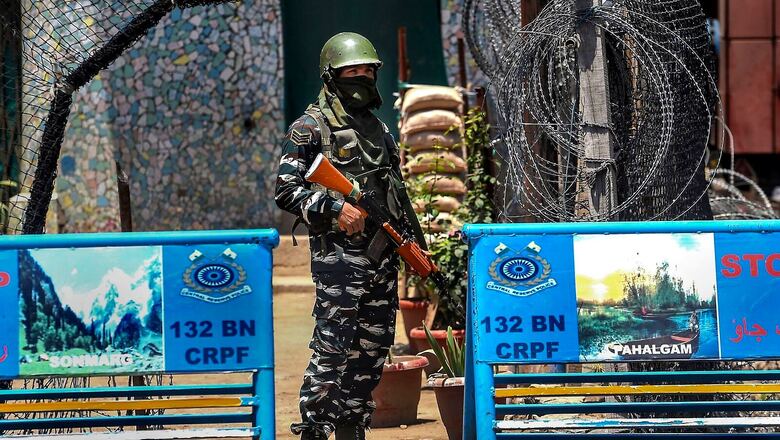
views
At the outset it’s important to send home the message that the current situation in Kashmir, involving targeted killing of minorities as well as those opposed to extremist ideology by quasi (not hybrid) terrorists is an issue which does not involve just the security domain but the societal domain too. Proxy hybrid conflict of the J&K kind is not just between terrorists and the security forces (SF). There is a political and social side to the entire phenomenon besides the fact that such events are a part of the grand design of the proxy war which Pakistan has sponsored for the last 32 years.
The proxy war in Jammu and Kashmir is obviously taking one of those twists we have got used to. We have often seen its transformation with different shades of violence. Only, this time the acts of violence are small with the cumulative effect being huge. While everyone regrets the targeted killings of migrant and resident Hindus, as also Muslims who may be considered working against the ethos of Political Islam and interests of Pakistan in the Kashmir Valley, it’s important to review and understand why this is happening. Plausible explanations come from the experience of being in the Valley, the groundswell of opinion in the field, and interaction with knowledgeable people who regularly observe J&K’s security and political space.
The Jammu and Kashmir proxy conflict has always been dynamic. That essentially means no side can claim victory with a successful act or series of acts as part of a campaign because these are invariably followed by counter actions to win back part of what is lost. The big political decision taken by the Narendra Modi government on August 5, 2019, removing J&K’s special constitutional status under Article 370 and reducing it to a union territory with Ladakh separated from it, was one of the biggest Indian initiatives in the conflict. The decision itself was not a victory, its progressive effect could, of course, ensure such victory.
It shook Pakistan and various other stakeholders, including separatists, ideologues and other anti-India elements. The security crackdown that accompanied was intense in dealing with the turbulent situation on the streets. As a result of higher securitisation after August 5, 2019, the political space also dwindled although the District Development Council elections were successfully held. One other basic observation, the state-level mainstream parties in the Valley got marginalised with no other political dispensation to take their place; the BJP’s political efforts in the Valley did not bear the desired fruit. The coronavirus pandemic over two years prevented any recovery of the extant situation.
On the security side, in their heyday the terrorist cadres would number over 3,000. Resolute military action at the LoC and the joint operations of the security forces in the hinterland over the years have reduced this strength to an estimated 175-200 terrorists or so. I term the campaign against these 175-200 terrorists as the ‘Last Mile’. It’s usually the most difficult part of any anti-terror campaign which also receives an inevitable push back. Agitation on the streets has almost disappeared because of crackdown on the sponsored networks which included political, ideological, financial and even media networks. On top of that, the security forces have been notching regular success. They eliminated 182 terrorists in 2021, and this year in five months the figures are topping over 80. The sponsors in Pakistan would obviously be unhappy to witness this state of things. If they did nothing fearing an FATF backlash, there was every possibility of falling below the threshold of acceptable effectiveness of the long investment made in Kashmir. ‘Keeping the flame burning’, is the phrase often heard about Pakistan’s strategy in J&K, even as it is internationally scrutinised for its linkages with sponsorship of terrorism.
The Pakistan decision to recapture separatist relevance and sentiment, compromised due to our actions, probably came about a month or two after the fall of Kabul and the US withdrawal from Afghanistan at the end of August 2021. In the choice of actions in the evolving strategy, two things probably remained high in priority. First, that the LoC must remain stable (it helps to apportion blame on India for internal unrest) and second, that the campaign should be all about targeting the softest targets. Targeting the minorities, single policemen, soldiers on leave, migrant labour and Muslims opposed to the ideology of radical extremism by young Kashmiri Muslims would deliver a body blow to the notion of normalcy in the Valley and create a political storm.
Smartly, instead of infiltrating hardcore Pakistanis to perpetrate these acts, very young motorcycle-borne and pistol-brandishing youth have been tasked to execute the missions. None of them are registered terrorists and perhaps do not repeat these acts. Expectedly, they are sufficiently radicalised too. This is obviously hugely aided by the fact that many Kashmiri Hindus also reside in the Valley, especially government servants; there is migrant labour too and others attempting to eke out a living by exploiting the excellent tourist season which is likely to see more footprints as the Sri Amarnath Yatra gets underway in the end of June. Except for a few clusters of accommodation constructed by the government to facilitate the return of the Kashmiri Pandits and other Hindus, most of the minority population live in hired accommodation with no incidental security.
Heightened vigil in the wake of minority targeting does not mean much. The intent of the adversaries is to trigger mass migration and discourage any possibility of demographic change in the Valley through settlement of people from the rest of India. It is also an attempt to recapture a part of the space lost by the separatist-terrorist combine as a result of the success gained by the Government of India decisions of August 2019. The issue is serious enough to merit consultations and ideation at the highest level. A mass migration would be a political embarrassment since the government cannot hold back people by force. I recall such a situation at the end of March 2000, in the wake of the Chittisinghpura incident when 36 members of the minority Sikh community were gunned down by the Lashkar-e-Taiba (LeT). It took much engagement by the political community cutting across all parties to ensure that no Sikh migration occurred.
So even as the Army, CRPF and J&K Police ideate and evolve security related responses which will inevitably mean sharper intelligence, more patrolling and domination, besides attempts at relocation of some minorities into securitised clusters, there is a need for reinvigoration of the political and social domains. This issue is unlikely to be resolved through only a security approach. Three measures are required and that too urgently. First, a political consensus needs to evolve to allow the political community to go to the people, appeal and engage with them to take ownership of the security of the targeted people. It’s the reputation of the Kashmiri people at stake. Second, the media and prominent members of the civil society from all faiths must rally to isolate the radical elements. The clergy’s role can hardly be understated. There is a ban on the Jamaat-e-Islami (JeI) Kashmir but its underhand role in the recruitment and financing process is often spoken of. It is up to the intelligence and other security agencies that a total focus is brought to eliminating this. Third, we need a scientific approach to counter radicalisation as a long-term measure.
It is often said that political activity at grassroots level is the panacea for most ills involving internal security. Jammu and Kashmir is an externally sponsored internal security issue and needs careful handling with a consensus approach. With the Sri Amarnath Yatra just a few weeks away, the current situation needs to be under the scanner and arrested by all means lest it trigger something even more dangerous.
ALSO READ | This is How India Can Counter Pakistan’s Dangerous Revival Game in Kashmir
The writer is a former GOC of the Srinagar-based 15 Corps and Chancellor, Central University of Kashmir. The views expressed in this article are those of the author and do not represent the stand of this publication.
Read all the Latest Opinions here




















Comments
0 comment